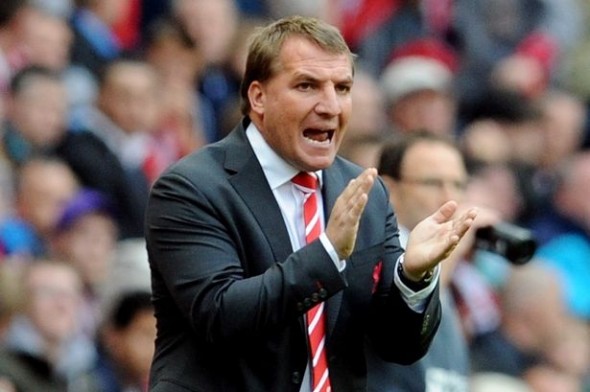
Brendan Rodgers has masterminded a surprise Premier League title challenge this season, and after a weekend of results firmly in the Reds’ favour, Liverpool appear on the cusp of a truly special achievement.
For many fans and neutrals, the Merseyside club weren’t even in the conversation for fourth place at the start of the season. Tottenham Hotspur, with £100 million worth of talent and Erik Lamela on board, were set to battle Arsenal for the final Champions League spot; Everton and Liverpool, being propped up by just a few key players each, were leagues behind.
But inside the final 30 days of the season, the Reds can win-out and land the title. How on earth have they done it?
Let’s take a tactical look at Rodgers’ Reds this season.
Early 4-3-3/4-2-3-1 Hybrid
Liverpool began the season without Luis Suarez (suspended for seven games), so for the opening game against Stoke City, Rodgers deployed a 4-2-3-1 formation that dropped into a 4-3-3 shell when out of possession.
The key was unlocking Daniel Sturridge as the Reds’ prime performer, allowing him to play as a central striker on the ball and drop wide when off it.
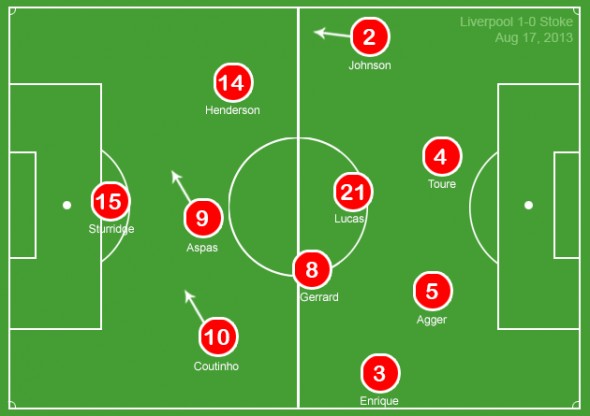
Steven Gerrard and Lucas Leiva played as a double-pivot with Jordan Henderson on the right side. After losing possession, Henderson would drop into RCM, Sturridge would become a right winger and Iago Aspas would go from No. 10 to centre-forward.
It allowed Liverpool to get three into midfield and cope with overloads, instilling a low block and focus on not conceding any goals. We’ve become accustomed to the Reds simply blitzing teams now, but their first three fixtures were all 1-0 victories.
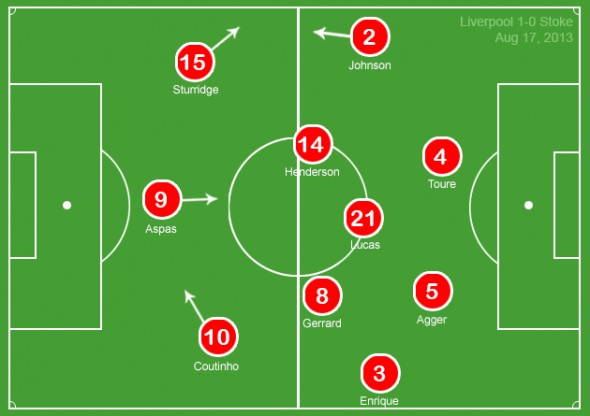
Working out from defence, the first port of call would be Sturridge: Can we get him the ball? can we ask him to carry us up the pitch?
Switching wide allowed him to perch 30 yards out free of markers, and a quick diagonal would always ensure he has the ball early with space to run into.
The Reds are excellent on the ball but they look even better on the counter. At first it was a method to negate the loss of Suarez, but they go so good at it so quickly, the Uruguayan began slotting into the system with ease.
Quizzical 3-4-1-2
After Suarez’s return and a summer spending spree that landed three new centre-backs, Rodgers attempted to change his system to accommodate his new options.
The 4-2-3-1/4-3-3 hybrid had been working out OK, but dropped points against Swansea City, Newcastle United and Southampton highlighted the squad’s main fragility: the lack of a physical anchor midfielder to help Steven Gerrard’s ailing legs.
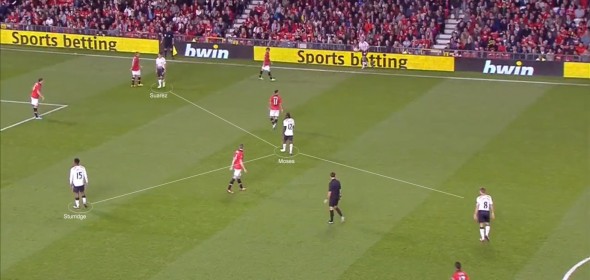
The 3-4-1-2 saw Mamadou Sakho, Martin Skrtel and Kolo Toure plugged into the defensive line, Jose Enrique freed as a wing-back and Henderson being played out of position on the right-hand side.
The system allowed one of the centre-backs, in theory, to step forward and fill the hole behind Gerrard and Lucas on the reverse while still retaining two men in defence. In a league where teams largely play one striker, that gives Rodgers a man advantage in both zones.
But ironically enough, the one player that this system suited more than any other—Philippe Coutinho—was out injured during the month Liverpool trialled it.
Victor Moses attempted to pick up the slack behind Sturridge and Suarez, but his performances have too often underwhelmed this season. The experiment was short-lived—perhaps unfairly so—but after a return to the 4-3-3, what came next was the catalyst for a title-challenging surge.
4-4-2 Diamond
Raheem Sterling re-emerged as an option for the first-team in December against Hull City but was poor on his return. His next game against Norwich was decidedly better, but it wasn’t until February when he truly began to move through the gears.
The dynamism and speed on show from the right wing—resulting in goals, assists, and Liverpool wins—convinced Rodgers to try him at the tip of a midfield diamond behind SAS. Henderson is the perfect box-to-box midfielder, and Coutinho was re-groomed to fulfil a new role on the other side.
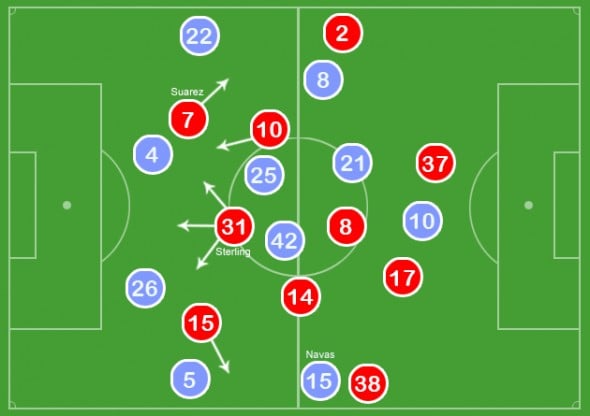
Gerrard plays at the base, controlling the tempo, pulling the strings and releasing runners with accurate balls. In the early stages of the diamond surging runs from Henderson were key to creating overloads, but as Sterling’s confidence has grown, he’s become the man to stop.
Suarez and Sturridge drop wide and pull markers away from the centre, making space for the 19-year-old to breach. The pace and energy in Liverpool’s midfield—Gerrard aside—has proven too tough for every defence to handle so far.
Concerns over a lack of width whilst in the diamond shape have been negated through aggressive positioning of players and periods of pressing; Liverpool can dominate long spells of games, thus masking the areas of suspicion in their side.
Conclusion
There have been errors from Rodgers this season, such as the putrid showing at Hull City and the four-centre-back approach at home to Southampton, but it’s been as close as you get to a perfect tactical campaign for the Ulsterman.
If the Reds do go on to win the title it’s Rodgers who can take the most credit. Suarez and Sturridge have been irresistible, but winning a Premier League trophy with such a mediocre defensive line is a work of art; Rodgers is the painter.

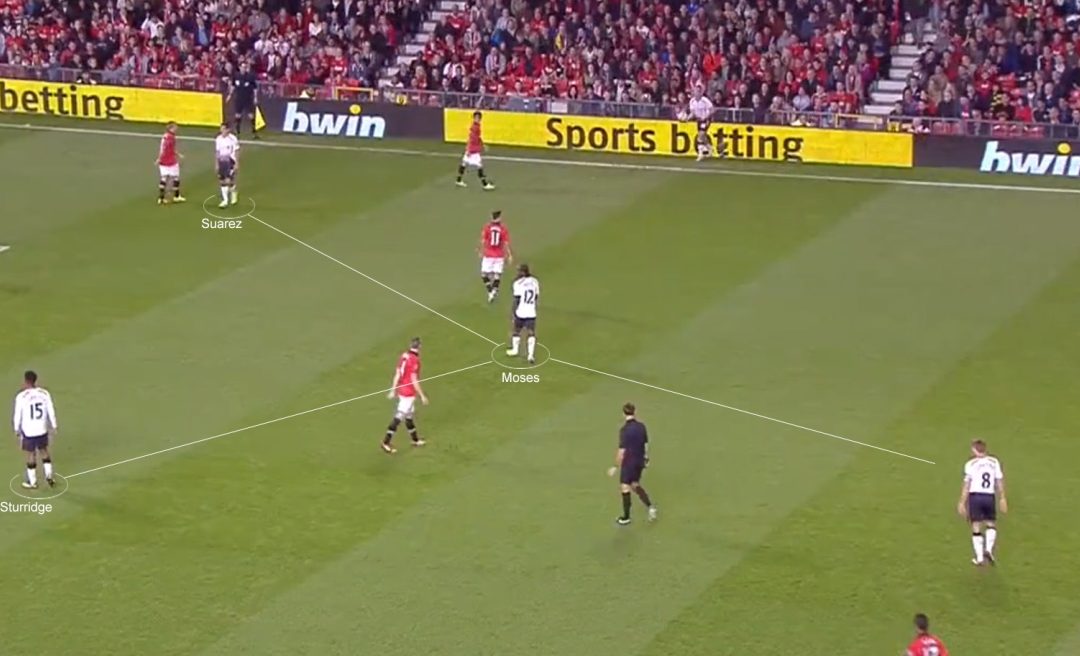









hi fantastic analysis of the way liverpool play, is there a website where i can have a look at sessions that you have done and more tactical analysis and information i can get on different systems pls